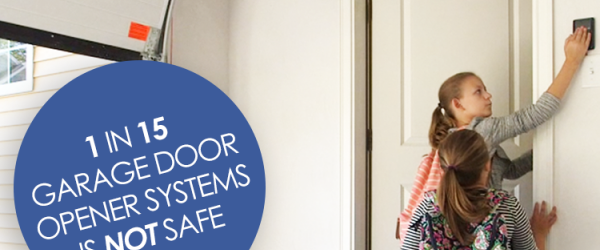
Garage Door Safety: 12-Step Inspection [Checklist]
Your garage door is something you likely use every single day - but how often do you really think about it?
Probably never, unless of course, something goes wrong.
And that's understandable, but much like you would with your car, it’s imperative that you put time aside (at least once a year) to inspect the safety and reliability of your garage door and garage door opener.
June is garage door safety month, so we put together a simple, 12-step inspection checklist that will help minimize the risk of any mechanical or safety issues.
1. CHECK THAT THE PHOTO EYE SENSORS ARE PROPERLY INSTALLED
The photo eye sensors are located on either side of the garage door. They should be mounted no higher than 6 inches off the ground.
- Verify that both of these sensors are at the right height and are securely attached to the wall.
2. CHECK THAT THE PHOTO EYE SENSORS ARE PROPERLY FUNCTIONING
Now, test the functionality of the photo eye sensors.
- Place an object that is over 6 inches tall at the edge of the garage door so that it blocks at least one of the sensors.
- Using the garage door opener, press the button to close the garage door. If the photo eye sensors are functioning correctly, the garage door should not close.
3. TEST THE GARAGE DOOR’S MECHANICAL REVERSE.
Your garage door's mechanical reverse feature should be functioning properly to ensure safety.
- Place an object that is at least 1.5 inches high at the edge of the garage door. (For example, you can use a plank of wood.)
- Using the garage door opener, press the button to close the garage door. The door should begin to close, but then reverse and start opening again once it touches the object.
If you experience any issues with the photo eye sensors during the inspection process, contact a reputable company for service like Fagan Door immediately.
4. TEST THE GARAGE DOOR’S BALANCE.
- First, switch the garage door opener into manual mode. Then, open and close the garage door. The door should move on the tracks smoothly.
- Next, open the garage door again, but this time let go of it halfway. If functioning correctly, the door should stop itself and hang in the middle instead of falling all the way to the ground.
If you sense any issue with the balance, contact an expert to help you.
(Please note that the balance is one of the hardest parts of the garage door to maintain and that it can be dangerous to adjust it yourself. For swift, safe, and reliable help, it is extremely recommended that you contact an expert.)
5. CHECK THE CONDITION OF THE SPRINGS.
A garage door has one of two types of springs: torsion springs or extension springs.
Torsion springs are located above the garage door when it is closed (parallel to its top). Extension springs are located above the upper tracks on both sides of the garage door.
- To check the condition of the springs, keep the door closed and visually assess the springs for any damage. If you hear any squeaking, lubricate the springs.
If the squeaking persists, this could be indicative of a more serious problem and you will need an expert’s evaluation.
Sensing a problem with your garage door opener’s springs? Contact Fagan Door for help.
6. CHECK THE CONDITION OF THE PULLEYS.
- Visually assess the garage door’s pulleys for any signs of wear and tear.
Please note that the pulleys (like all other parts of the garage door opener that are attached to the springs) are under very high tension. As a result, it is very dangerous to attempt to service them without an expert’s help.
If you suspect that there is something wrong with your garage door’s pulley, contact Fagan Door for help.
7. CHECK THE CONDITION OF THE LIFTING CABLES.
- Visually inspect your garage door opener’s lifting cables. Look out for any broken or fraying strands.
- Pay special attention to the parts of the cable near the bottom of the roller bracket. These parts of the cable usually deteriorate more quickly as they are more likely to be exposed to moisture.
Again, please note that it can be very dangerous to attempt to replace your garage door’s cables yourself.
8. CHECK THE CONDITION OF THE ROLLERS.
- Inspect the rollers on your garage door for any signs of wear and tear. Generally, there are two types of rollers, and they typically show signs of deterioration differently.
Nylon rollers typically tend to crack and chip. Fortunately, this kind of damage is easy to spot.
Steel rollers, on the other hand, tend to slowly become bent out of shape. You must look closely to spot this kind of wear.
9. CHECK THE CONDITION OF THE GARAGE DOOR’S TOP AND BOTTOM FIXTURES.
- Inspect the brackets at the top and bottom of your garage door for any loose screws.
- Because your garage door is always moving, these parts can easily become loosened. (Don’t forget to check the screws on the rollers’ brackets, as well.)
(Caution: do not loosen the screws in the bottom brackets of your garage door. These brackets are connected to the springs and are under very high tension.)
10. CHECK THE CONDITION OF THE HINGES.
- Visually check the hinges on your garage door for any signs of damage.
- Ensure that all hinges are firmly attached and anchored - you do not want to allow any part of the hinge to become loose.
Remember, it is important not to tamper with the hinges on your garage door as it can be extremely dangerous. If you believe that your hinges need to be replaced, we recommend you contact a professional and reputable garage door service company for help.
11. CHECK THE CONDITION OF THE BOTTOM RUBBER.
The long strip of rubber on the bottom of your garage door is meant to seal away any water, dirt, insects, etc.
- Check that this bottom rubber has not become brittle or worn out over the year.
If the bottom rubber does need to be replaced, this is a relatively simple project that you can tackle yourself, if you so choose.
12. CHECK THE CONDITION OF THE PERIMETER WEATHER SEAL.
Wind, rain, dirt, and the like can get into your garage through the top and sides of your garage door. For this reason, most garage doors will have a protective perimeter weather seal.
- As with the bottom rubber, visually inspect your garage door’s perimeter weather seal to see if it has become worn away or ripped. Replace as needed.
--
Remember, a garage door is the largest and heaviest moving object of a home, and it's incredibly important that it functions safely, reliably, efficiently.
Take just 20 minutes out of your day to complete this simple, 12-step garage door safety inspection list.
If you have ANY suspicion that your garage door may need servicing, contact a professional garage door service company immediately.
Fagan Door's reputable team of repair & installation professionals are happy to answer any questions. Give us a call at (401) 821-2729!
